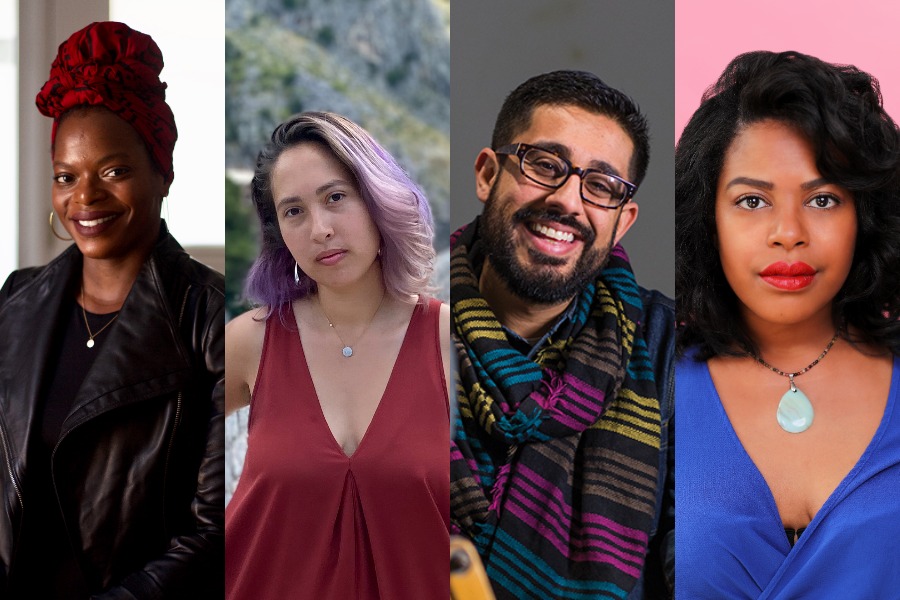NEW YORK CITY: Baltimore Center Stage, Woolly Mammoth Theatre Company, Long Wharf Theatre, and the Repertory Theatre of St. Louis have announced a joint effort to hire a group of freelance artists to participate in a year-long Artistic Caucus as key parts of the artistic development teams within each theatre, and across all four theatres. The new initiative, which combines the forces and resources of four institutions as an investment in interconnection and abundance, is supported by the Andrew W. Mellon Foundation and the Doris Duke Charitable Foundation.
“The four of us have been working together formally in these positions for just a few years, but we’ve been informally collaborating our entire careers,” shared artistic directors Hana Sharif (Repertory Theatre of St. Louis), Jacob Padrón (Long Wharf Theatre), Maria Goyanes (Woolly Mammoth Theatre Company), and Stephanie Ybarra (Baltimore Center Stage) in a joint statement. “Our field has long operated through the organic relationships formed among theatremakers, and this Artistic Caucus is our latest way of naming that trend and optimizing for it. By combining our intellectual and financial resources and increasing interconnection at every artistic level of our organizations, we are able to force multiply to throw our doors even further open, evolving how we bring artists into our communities toward more equality, more transparency, more accessibility, more trust, and more abundance.”
This new shared Artistic Caucus is made up of theatre artists based around the country, with inclusion in the caucus intentionally not limited to those in traditional literary manager or dramaturg roles, and, as Ybarra put it in an interview, are not limited in their “creative palette—all modes of storytelling are going to come into play.” The four inaugural Artistic Caucus members are Marie Cisco, Nailah Harper-Malveaux, Adil Mansoor, and Regina Victor, who will be joined by Baltimore Center Stage’s director of artistic partnership and innovation, Annalisa Dias; the Repertory Theater of St. Louis’ producer of new-play development, Becks Redman; Woolly Mammoth’s director of new work, Sonia Fernandez; and Long Wharf’s artistic associates Cheyenne Barboza and Kate Moore Heaney.
“I am especially excited that the caucus brings together an ensemble of folks interested in curatorial disruption,” said Mansoor in a statement. “I appreciate that the strategies and deliverables of our work together weren’t predefined and are coming out of our time together. It’s thrilling to experiment with a curatorial model that resembles a devising process and encourages emergent possibilities.”
As part of their work, the Artistic Caucus will read new plays and proposals, scout projects, and facilitate relationships with artists on behalf of all four theatres. With this caucus, the theatres are venturing to open up the frequently competitive and opaque artistic development process by working with artists to help identify projects, paying them for their expertise, and positioning the different artistic priorities for each organization as a place of strength and cooperation. This new model aims to make space for more entryways into the artistic development pathways, more touchpoints for artists, more voices in the room, and more visions for what theatre can be than what has been available through traditional structures of literary management.
The artistic directors of these theatres formed a cohort as four newly appointed artistic directors of color at major regional theatres, sharing a singular goal of creating artistic homes across the country that are inclusive, intersectional, and focused on the liberation of all people, using transparency, shared learning and collective resource mining.
What will come of the Caucus in a year, and how will they measure success? In an interview, Ybarra said the Caucus’s work is likely to influence season planning conversations for next year and beyond. And though there are no firmly defined production slots earmarked for the new work considered and developed as part of the Caucus process, Ybarra did say that one measure of this initiative’s success will be “looking at our ability to work across multiple organizations: How often does that happen? And how well does that go? One of the metrics will be how much we can share out to the field as we go through this, to say, ‘Here’s what we’re learning and doing.’ We’re doing this not just for ourselves, but as a broader fieldwide experiment.”
Is that part of the transparency element will work? Does the hiring of four new artists not simply add more gatekeepers to the mix? Said Ybarra, “That’s an active conversation, a work in progress. We are very intentionally bringing aboard a group of people who have a strong analysis in what it means to be antiracist, anti-oppressive, and anticolonial, and to put that lens on our processes. That will be emergent in our practice, and it’s been a very deliberate part of our interviews for the Caucus.”
In all, she said she hopes for a “force-mutliplying effect,” and that “everything is on the table” in terms of how the Caucus’s efforts will show up onstage and off- at these four theatres and beyond. “We’ve been careful to scaffold this enough to give us some parameters, but not so much that we’re limiting our own capacity to dream together. We’re at beginning of this process; we’ve invited the caucus members, and we’ll reading scripts and talking about favortie artists. But we’ll also be on the lookout for possibilities we haven’t seen before.”


